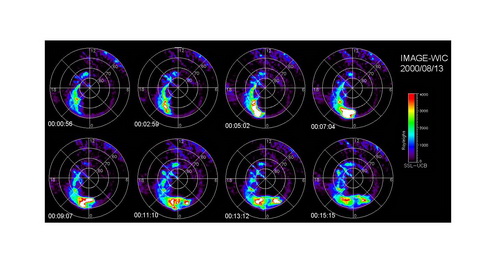Solar Wind Energy Input during Prolonged, Intense Northward Interplanetary Magnetic FieldsUpdate time:01 20, 2012
Professor DU Aimin and his team research the solar wind energy input during prolonged, intense northward interplanetary magnetic fields (IMFs). They derive a new solar wind–magnetosphere coupling function during northward IMFs. This concept is defining one for energy release(ER)/substorm energy storage. Their scenario indicates that the rate of solar wind energy injection into the magnetotail/magnetosphere/ionosphere for storage determines the potential form of energy release into the magnetosphere/ionosphere. This may be more important to understand solar wind–magnetosphere coupling than the dissipation mechanism itself (in understanding the form of the release). The concept of short-term energy storage is also applied for the solar case. It is argued that it may be necessary to identify the rate of energy input into solar magnetic loop systems to be able to predict the occurrence of solar flares.
Figure 1. The Wideband Imaging Camera (WIC) images from IMAGE satellite during ER. (Image by DU) Du et al. Solar Wind Energy Input during Prolonged, Intense Northward InterplanetaryMagnetic Fields: A New Coupling Function. Journal of Geophysical Research. 2011,116,A12215,doi:10.1029/2011JA016718 (Download Here) Du et al. Observations of dawn-dusk aligned polar cap aurora during the substorms of January 21, 2005. Planetary and Space Science. 2011, 59(13) :1551-1558(Download Here) Du et al. Anomalous geomagnetic storm of 21–22 January 2005: A storm main phase during northward IMFs. Journal of Geophysical Research. 2008, 113, A10214, doi:10.1029/2008JA013284 (Download Here)
|
Contact
Related Articles
Reference
|
-
SIMSSecondary Ion Mass Spectrometer Laboratory
-
MC-ICPMSMultiple-collector ICPMS Laboratory
-
EM & TEMElectron Microprobe and Transmission Electron Microscope Laboratory
-
SISolid Isotope Laboratory
-
StIStable Isotope Laboratory
-
RMPARock-Mineral Preparation and Analysis
-
AAH40Ar/39Ar & (U-Th)/He Laboratory
-
EMLElectron Microscopy Laboratory
-
USCLUranium Series Chronology Laboratory
-
SASeismic Array Laboratory
-
SEELaboratory of Space Environment Exploration Laboratory
-
PGPaleomagnetism and Geochronology Laboratory
-
BioMNSFrance-China Bio-mineralization and Nano-structure Laboratory

 Print
Print Close
Close
